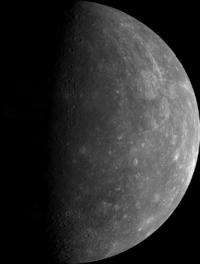Mercury. Credit: NASA
With both x-ray and gamma-ray spectrometers, the MErcury Surface, Space ENvironment, GEochemistry and Ranging probe (MESSENGER), which entered orbit around Mercury in 2011, is well equipped for carrying out a detailed compositional analysis of Mercury's crust, the understanding of which could help determine the nature of the planet's formation, and of its volcanic past.
Using spectrometric measurements and laboratory analyses of Mercury surface-analogue samples, Stockstill-Cahill et al. determine that the upper layers of Mercury's crust most closely resemble magnesian basalt terrestrial rocks, though with lower iron concentrations. To make their determination, the authors used a software package known as MELTS to simulate the cooling and crystallization of potential Mercurian lavas with different chemical compositions, estimating the temperatures at which minerals would crystallize out of the molten lava and the abundances of different mineral species. Similarly, the authors simulated the cooling of magnesium-rich terrestrial rocks and of meteoritic samples.
Based on their chemical compositional analysis, the authors infer a number of properties for an early lava on Mercury. They suggest that the lava would have had a very low viscosity, streaming across the surface in widespread but thin layers. Further, they calculate that the temperatures required to produce the magnesium-rich lava would have been much higher than for terrestrial rocks not enriched in magnesium.
The authors say that the low-viscosity lava would leave tell-tale marks on the planet's surface that could be identified through further MESSENGER observations.
More information: Magnesium-rich crustal compositions on Mercury: Implications for magmatism from petrologic modeling, Journal of Geophysical Research-Planets, doi: 10.1029/2012JE004140, 2012 onlinelibrary.wiley.com/doi/10 … 012JE004140/abstract
Provided by American Geophysical Union






















